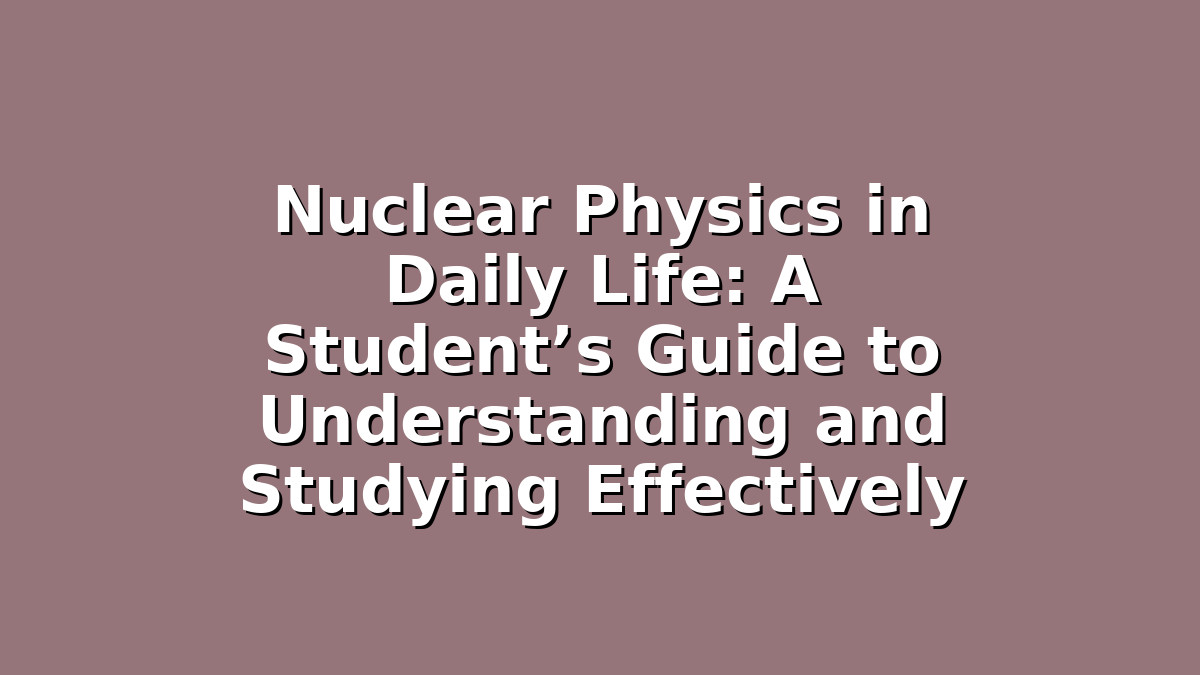Nuclear physics might sound like a complex and distant field, but its principles and applications influence many aspects of our daily lives. For students preparing for exams or looking to deepen their understanding of this fascinating subject, recognizing the real-world impact of nuclear physics can make studying more engaging and meaningful. In this article, we will explore how nuclear physics is relevant in everyday life, provide study tips tailored to mastering its concepts, and share strategies to help you excel in your exams.
Understanding Nuclear Physics and Its Daily Impact
Nuclear physics is the branch of physics that deals with the components and behavior of atomic nuclei. While it may seem like a topic confined to high-tech labs, nuclear physics plays a pivotal role in energy production, medicine, and even our environment.
For example, nuclear power plants generate a significant portion of the world’s electricity through nuclear fission, a process where atoms split to release energy. In medicine, nuclear physics contributes to diagnostic tools such as PET scans and cancer treatments like radiation therapy. Additionally, understanding radioactive decay helps us measure the age of archaeological findings and monitor environmental radiation.
Realizing these connections can motivate you as a student to see nuclear physics not just as abstract theory but as a practical science shaping modern life. This perspective will help you stay curious and focused while preparing for your exams.
Section 1: Connect Theory with Real-Life Examples to Enhance Understanding
One of the best ways to grasp nuclear physics concepts is by linking them to everyday situations or current events. This approach makes your study sessions more relatable and helps reinforce memory retention.
Start by identifying key topics in your syllabus, such as radioactive decay, nuclear reactions, and radiation types. Then, find examples around you:
– Radioactive Decay in Smoke Detectors: Many household smoke detectors use Americium-241, a radioactive element, to detect smoke. Understanding how alpha particles emitted by Americium interact with air molecules can clarify the concept of alpha decay.
– Nuclear Medicine: Learning how radioisotopes are used in PET scans to diagnose diseases can give context to the use of gamma radiation and half-life calculations.
– Environmental Radiation: Background radiation from natural sources, like radon gas in basements, helps illustrate how radiation is present everywhere, not just in nuclear facilities.
Incorporate these examples into your notes and try explaining the concepts aloud using these scenarios. Teaching others or discussing with study groups this way can deepen your comprehension and reveal gaps in your knowledge.
Study Tip: Create a “Real-Life Nuclear Physics” notebook where you jot down news articles, documentaries, or personal observations related to nuclear applications. Revisiting this notebook before exams will refresh your understanding and make your answers more insightful.
Section 2: Use Visual Aids and Interactive Tools for Better Retention
Nuclear physics involves abstract phenomena that aren’t visible to the naked eye, making it challenging to visualize. Using diagrams, animations, and simulations can bridge this gap and make learning more effective.
For instance:
– Energy Level Diagrams: These visuals depict how an unstable nucleus emits radiation to reach a stable state. Drawing and labeling these diagrams yourself will improve your ability to recall and explain decay processes.
– Interactive Simulations: Websites like PhET Interactive Simulations provide free tools where you can experiment with models of nuclear reactions, radioactive decay, and particle collisions. Playing with these simulations helps you see cause and effect in real time.
– Videos and Animations: Watching short educational videos that animate nuclear reactions or radiation interactions can clarify complex topics quickly.
Incorporate these visual aids regularly during your study sessions. When reading your textbook or notes, pause to sketch diagrams or look for multimedia resources that complement the material.
Study Tip: Combine visual aids with active recall. After reviewing a diagram or simulation, close your materials and try to redraw or explain the process from memory. This strengthens neural connections and boosts exam performance.
Section 3: Practice Problem-Solving and Past Exam Questions Strategically
Mastering the numerical and conceptual problems in nuclear physics requires consistent practice. Exams often test your ability to apply formulas, analyze data, and interpret experimental results.
To build confidence and proficiency:
– Understand the Formulas: Common formulas involve radioactive decay law (N = N₀e^(-λt)), half-life calculations, and energy released in nuclear reactions (E=mc²). Don’t just memorize these; understand what each variable represents and how to manipulate the equations.
– Solve Step-by-Step: When tackling problems, break them into smaller parts. Identify known and unknown variables, write down relevant equations, and perform calculations carefully to avoid mistakes.
– Review Past Papers: Practicing with previous exam questions familiarizes you with the question formats, common traps, and time management. After solving, compare your answers against mark schemes to identify areas for improvement.
– Work in Study Groups: Collaborating with peers allows you to discuss challenging problems, share solution methods, and learn alternative approaches. Teaching a concept or problem solution to someone else is one of the best ways to solidify your understanding.
Study Tip: Allocate specific time each week to practice problems and review feedback. Use a mix of easy, medium, and difficult questions to build your skills progressively. If possible, consult your teachers or tutors for guidance on tricky topics.
Conclusion: Embrace the Relevance of Nuclear Physics and Study Smart
Nuclear physics may seem intimidating at first, but recognizing its role in daily life makes it more approachable and exciting. By connecting theory to real-world examples, leveraging visual aids, and practicing problem-solving with purpose, you can transform your study routine into an effective and rewarding experience.
Remember, persistence is key. Don’t hesitate to ask questions, seek help when needed, and use a variety of learning tools to find what works best for you. With consistent effort and a positive mindset, you’ll not only succeed in your exams but also gain a deeper appreciation for how nuclear physics shapes the world around us.
Keep exploring, stay curious, and good luck with your studies!

Responses